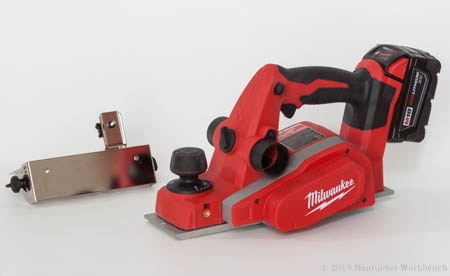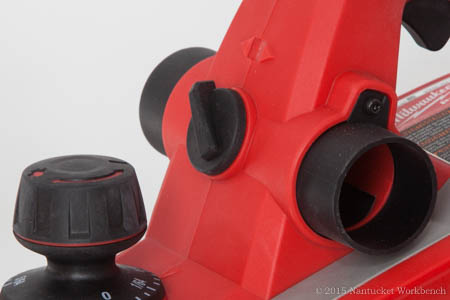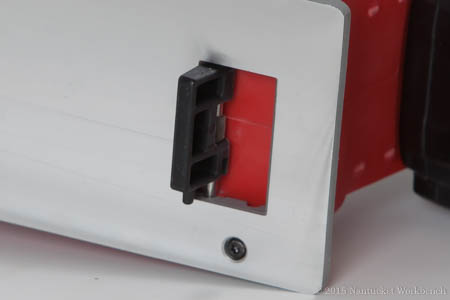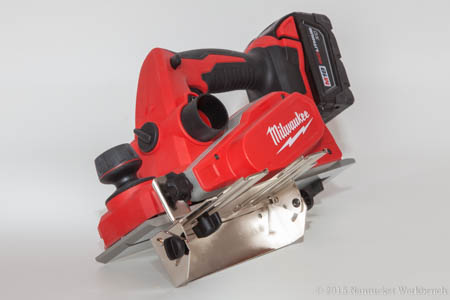 I’ve been waiting for the launch of Milwaukee’s new M18™ 3¼” Planer since giving it a try at their New Product Symposium back in June, and it’s finally here. I’ve never used my corded planer that much, long having a preference for my vintage planes. I limited my power planing to times when I needed to do wholesale stock removal, usually from framing members already in position when they interfered with sheetrock or trim. It was rare that I used it on a door edge or a cabinet scribe. There are three things about the new Milwaukee offering that made me reconsider: the cordless operation, the switchable exhaust port and the easy turning of the indexed depth adjuster. The benefits of a cordless tool are obvious. The advantage of being able to choose a left or right exhaust direction are pretty clear too. I often declined to use my 20 year old Makita because my right-handed operation covered the workbench and everything on it with shavings. Now, with the M18™ Planer, I can shoot them all to the floor or hook up a vacuum and keep the bench and the floor clear.
I’ve been waiting for the launch of Milwaukee’s new M18™ 3¼” Planer since giving it a try at their New Product Symposium back in June, and it’s finally here. I’ve never used my corded planer that much, long having a preference for my vintage planes. I limited my power planing to times when I needed to do wholesale stock removal, usually from framing members already in position when they interfered with sheetrock or trim. It was rare that I used it on a door edge or a cabinet scribe. There are three things about the new Milwaukee offering that made me reconsider: the cordless operation, the switchable exhaust port and the easy turning of the indexed depth adjuster. The benefits of a cordless tool are obvious. The advantage of being able to choose a left or right exhaust direction are pretty clear too. I often declined to use my 20 year old Makita because my right-handed operation covered the workbench and everything on it with shavings. Now, with the M18™ Planer, I can shoot them all to the floor or hook up a vacuum and keep the bench and the floor clear.
 Switching from left to right exhaust is a simple matter of turning the knob at the front of the handle. Equally simple is the depth adjustment. The knob is clearly marked and indexed with 20 positions, there being four clicks from one 64th to the next. This allows for easily repeatable set-ups, doing away with the need to re-zero between cuts. The top of the knob is marked with an arrow for people like me who have a hard time remembering which way goes up and which way goes down. The range of adjustment and tool configuration allow for a rabbeting depth of 27/64″, or just shy of 7/16″. While I have never cut an entire rabbet with a planer, it could be useful for cleaning up slight mismatches in shiplapped boards and the like. The example I have in hand would require the use of the fence even in an existing rabbet, however, because the blades are wider than the sole(s) of the plane. The sole edges cannot be used as a guide. The front sole is able to rotate a bit in plane, not lining up with the rear. I don’t know it this is a problem, but it’s unexpected. It is also a different width than the rear.
Switching from left to right exhaust is a simple matter of turning the knob at the front of the handle. Equally simple is the depth adjustment. The knob is clearly marked and indexed with 20 positions, there being four clicks from one 64th to the next. This allows for easily repeatable set-ups, doing away with the need to re-zero between cuts. The top of the knob is marked with an arrow for people like me who have a hard time remembering which way goes up and which way goes down. The range of adjustment and tool configuration allow for a rabbeting depth of 27/64″, or just shy of 7/16″. While I have never cut an entire rabbet with a planer, it could be useful for cleaning up slight mismatches in shiplapped boards and the like. The example I have in hand would require the use of the fence even in an existing rabbet, however, because the blades are wider than the sole(s) of the plane. The sole edges cannot be used as a guide. The front sole is able to rotate a bit in plane, not lining up with the rear. I don’t know it this is a problem, but it’s unexpected. It is also a different width than the rear.
 The planer has a built-in kickstand at the rear to keep the blades from contacting the surface where the tool is placed when not in use. While not a Milwaukee exclusive, it’s a welcome feature. The stand has a small knob on one side, and the whole piece can be slid sideways to engage in a cutout to keep it in the retracted position if preferable. Good luck in keeping it there! I imagine that the pivot point of the stand determines the ease with which it swings out of the way. When this one hits the wood in the beginning of a pass, there’s a noticeable catch. I have not found any marks on the wood surface to indicate a problem, but it’s a distraction. That said, I like being able to set the tool down without having to lay it on its side.
The planer has a built-in kickstand at the rear to keep the blades from contacting the surface where the tool is placed when not in use. While not a Milwaukee exclusive, it’s a welcome feature. The stand has a small knob on one side, and the whole piece can be slid sideways to engage in a cutout to keep it in the retracted position if preferable. Good luck in keeping it there! I imagine that the pivot point of the stand determines the ease with which it swings out of the way. When this one hits the wood in the beginning of a pass, there’s a noticeable catch. I have not found any marks on the wood surface to indicate a problem, but it’s a distraction. That said, I like being able to set the tool down without having to lay it on its side.
After planing 550′ of Alaskan Yellow Cedar with the M18, my finger got tired holding down the trigger. It seems like a minor thing, but the switch spring is pretty stout! I also found that I had to go slowly to avoid chatter marks. With two blades and a no-load speed of 14,000 RPM, is this inevitable? I can move my hand planes faster, but they are much less forgiving of the wild grain patterns of the fast-growth wood that comes into the shop these days. That brings up a point that strongly recommends a power planer; much of what I work with is poplar, and primed poplar at that. With a coat of paint hiding the grain, I can no longer choose a board with a plane in mind so I never know how well my hand planes will work. A power planer can handle that unpredictability with consistently good results.
 I’ve had a bit of trouble avoiding snipe at the end of the passes, but it helps to hold my other hand on the planer body under the handle to keep the rear sole firmly on the workpiece. This is likely to be a problem only because of my lack of experience with a power planer. However, I’ve been getting snipe at the beginning of the passes too, so I will have to compare this and the Makita planer to look for physical differences in the tools. I’m wondering if the throat is wider on the Milwaukee. Those observations will be an addendum to this post.
I’ve had a bit of trouble avoiding snipe at the end of the passes, but it helps to hold my other hand on the planer body under the handle to keep the rear sole firmly on the workpiece. This is likely to be a problem only because of my lack of experience with a power planer. However, I’ve been getting snipe at the beginning of the passes too, so I will have to compare this and the Makita planer to look for physical differences in the tools. I’m wondering if the throat is wider on the Milwaukee. Those observations will be an addendum to this post.
The M18 Planer seems like a robust tool that will see a lot of use in the shop even if many of the last passes will still be done with the vintage iron. I think the planer will be a considerable time-saver as I change the way I do things and embrace the newer technology, but I remain curious about the launch of this particular iteration. Why is it not powered by a brushless motor? I was told at the New Product Symposium that the brushless motor was considered but not chosen because the planer was an intermittent-use tool and the advantage would be slight. As others have pointed out, most of the cordless tools we use are intermittent-use, yet most at this point are brushless. I can’t help but think that the dressing of the edges of 550′ of boards as I just did would have benefited. I would have liked more run time although I can’t claim that the battery swap was an inconvenience. That brings up another point; why does the kit ship with only one battery, and an obsolete REDLITHIUM™ XC battery at that? Are they depleting inventory? It makes the planer seem like a poor cousin to the premier tools in the Milwaukee lineup. In spite of these observations, I wouldn’t hesitate to add this to the arsenal. I intend to try to wear mine out.
[addendum]
I received this response from Milwaukee’s Heather Markovich to answer the questions I raised at the end of the above blog post:
Just got a chance to read your review of the M18 Planer. Glad to see you enjoyed using it.
I did want to take a moment to respond to some of the questions you had at the end.
Why is it not brushless?
You actually started to answer this in your article. When we design tools, we don’t immediately look at how to give them the most power. The decisions behind this tool’s design are based on extensive user research. Our team saw that the majority of typical users use this type of planer intermittently and not for hours at a time; whereas users of our drills, for instance, typically use them every day and for hours at a time. So, we made the decision to not make this brushless because we noticed the vast majority of our users wouldn’t necessarily notice the benefit.
Brushless isn’t just about power and runtime, too. Brushless also gives our tools extreme durability. Due to the usage patterns we saw with this type of tool, we didn’t see a direct need.
Why was it shipped with the XC battery and only one?
Again, based on user patterns we noted the tool could accomplish the majority of users’ demands with one battery. The XC battery we included is actually not obsolete; rather, it was determined this battery would provide the perfect amount of runtime for the tool.
In the end, we were able to deliver a brushed product with excellent power and runtime, at an affordable price point.
I hope this helps explain some of our decisions.
Heather Markovich
Assistant Brand Manager For Milwaukee Tool
-dvl


Awesome blog! This planer would definitely come in handy at work. I would love to see Milwaukee make a track saw and some cordless nail guns.
Great review Dirck, this planer looks great, love how you can switch sides for the discharge, Milwaukee really thought this design through. It sounds a lot different then Makitas. I would love to see a comparison of the two. Not just for speed but weight, feel and quality of the finished work. Milwaukee is definitely moving in the right direction with woodworking tools. Would love to see some cordless nailers from them.
Some of the comments suggest that Milwaukee make some lawn and garden tools, I feel that would be a bad decision due to the already high competition with brands such as Husqvarna or Stihl.
As far as woodworking tools go, Milwaukee doesn’t make stationary products. Although Milwaukee fans would like to see table saws or band saws or maybe even bench top sanders, I think a more likely scenerio for them is to make some hand tools. They might be able to make a durable, sharp, and long lasting chisel set. They pretty much have a lot of the cordless tools covered.
Don’t get me wrong, I’d love nothing more than to see a line up of woodworking machinery from Milwaukee, I just don’t see it happening any time soon.
A cordless router may be an idea, however the design of a router does not exactly accommodate a battery.
I came here from your Instagram account! Thanks.
@jnefsky
Just discovered this site today! Great stuff!
Would love to get one of these planers!
Looks gorgeous.
This looks like an awesome planer! I would love to see Milwaukee get some m18 nail guns and a Drywall screw gun with cut out tool. More carpentry specific tools.
Great review. Would also love to see Milwaukee do a band saw for the home shop. They make great tools and always looking for the next new thing from them.
Pneumatic finish guns!!
Lawn tools!!!!
Mower!!!
Blower!!!
Hedge trimmer!!
All cordless of course!!!
Great review about the M18 planer! I’d love to add this to my collection of Milwaukee tools. Additionally, I’d love to see Milwaukee come out with a plunge cut track saw in the future. Thanks for the opportunity on IG!
Cheers, Brendan
-Rare Earth Fine Art-
It would be great to see a cordless brad nailer from them.
I’d like to see Milwaukee make a deep reach bandsaw for small workshops.
I’d love to see Milwaukee produce something like a bench top jointer. Perhaps modular, using this planer as the business end, make a carcass to put it in that effectively turns it into a bench top jointer. I’ll build my own, but something manufactured well (light, well engineered, fence square to the planer blades, etc) would be nice at a reasonable price point.
Looks awesome
This is awesome! Would make a great addition to the shop and allow me some more mobility in where I can work
Looks awesome! Would love to try it out. As seen on instagram!!
My husband and I just bought our first home and are slowly building our tool collection to work on projects around the house. We love what we’ve been seeing on your Instagram and website. Keep it up!!
This and all the new Milwaukee tools look really awesome. This would be a great addition to my workshop.
I would love to see Milwaukee bring the same quality and innovation to a Table Saw. Corded tools have often been left behind, in regards to new and innovative features. Also Milwaukee needs to bring out the cordless framing and brad nailers in order to catch up to the rest of the market.
Everybody makes drills and impact drivers. Good to see Milwaukee add woodworking tools to their lineup.
Would love to add this to my Milwaukee collection. Cordless plainer?! Just makes life easier.
@nikmancini
Awesome job on the Milwaukee tool posts. I would like to see this planer added to my collection. I also would like to see Milwaukee bring the cordless mitersaw to the US
Brent, the cordless miter saw exists! I have seen it, but we were not to photograph it. There’s been no word on when it will launch.
What a beautiful tool!
This looks great!!! Good job Milwaukee. Great IG pics and reviews!! Keep up the good work!
I would love to see you guys bring out a cordless nailer. My Instagram name: @ sherwinenglish
I am an amateur woodworker, @carpenterviking on Instagram, and I would love to get my hands on this planer!
Hello i am a carpenter residing in California, originally from Great Britain. I love how many great tools Milwaukee produce and the quality of them too. I recently bought the drill and impact driver combo and battery circular saw which i have been more than satisfied in. A planner would be a much appreciated addition.
I am just getting into the Milwaukee. A planer is not something I use much but would be a great tool to add to my ever growing collection. Love the info I get from you guys especially thru Instagram. Thanks. Tyler
Cordless Nailer needs to be next would definitely make me switch from desalt 18v
This would go real nice with the new Milwaukee impacts I’ve just bought! Last impact lasted over three years so u know they are quality. Would really like to see battery finish and pin nailers so I can be full Milwaukee.
Ps nice blog
I want to try this thing badly! I’m new to using battery powered tools but so far they are awesome. The only things that I used to have battery powered were my drills and impacts. Now I can get anything I want battery powered. I would like to see a battery router. I would use it to route out sheathing over Windows. My Instagram name is northeconstruction
I’m new to wood working and love Milwaukee tools. I’d love to add this to my small but growing tool collection. I would love a cordless orbital sander as a few have mentioned.
Have to say, these new cordless tools are impressive. I would love to own one of these babies. Battery quality has come so far.
This is awesome! I would love to see the 18v hackzall go fuel! Instagram name: @whiskeynwood
Thanks!
I love woodworking, and building my tool collection slowly. A planer would surely come in handy.
I would like to see a drywall gun as well.
Hey guys great tool. I’m a young carpenter on island. I work for a company n do tons of side jobs. Great tool! Don’t own any Milwaukee stuff myself or a power plainer, but the plainer looks like a life saver. Good luck all who want it. Love the Instagram u guys run. Have a good one.
Thanks Lance! I work at Marine. Maybe I’ll see you there.
Like a few of the other commenters on this page, I’d like to see Milwaukee follow suit with a cordless random orbit sander. Great review on the planer!
I would love for them to make a M18 fuel hackzall
Thanks for the review! Looks like an awesome tool. These tool manufacturers are really making it easy to cut the cord! Looking forward to the Makita update.
I would love to see Milwaukee make a cordless m18 Palm drill. I had opportunity to use one a few years back and I absolutely loved it. It could get into places that normal drills could not. Though it was corded I loved it for fitments on a boat. The small compact design is fantastic. If you look on eBay these drill are regularly being sold to a loyal following. If they could design the drill while keeping the battery close with a compact design.
I own A couple of m12 tools which are small and amazingly powerful… Love your website 👍
Defiantly could use a planer!!!!!!!!!
Cordless track saw
This looks like a great tool! The fact that it isn’t brushless does not bother me. I never use one all day. I do a few cuts and set it down. Come back later and do a few more. Intermittent like Milwaukee said. Yes the battery changes would be fewer but I don’t think it would be enough to matter. What I would like to know is does the planet have the same performance as the corded version with new blades? Tools I would like to see are cordless finish guns an m18 fuel Hackzall a 6 inch random orbit sander to compete with the Mirka DEROS with a 5″ pad to interchange. I hope the new fuel 10″ miter saw is double bevel because I am not impressed with the 7 1/2″ Makita
Definitely a drywall gun!
Milwaukee needs to make some cordless sanders. Bosch and Makita make at least one model each, and Ryobi has multiple models. And an M18 Fuel Barrel-handle jigsaw. Makita Japan is innovating at an extreme rate, and when Milwaukee’s woodworking line is missing essentials like an up to date jigsaw and sanders, it’s hard to justify sticking with red.
Cory, I agree. I’m still waiting for the M18 Coffee Maker.
This planer looks like it will do the trick nicely. Cordless nail guns would be a great addition to an awesome lineup.
Love your page! Would love to see a m18 fuel drywall gun and an m18 fuel hackzall
I’m an @dlbuilders on Instagram
Thanks Duncan!
Milwaukee needs to get a jump on brushless nailer game, this planer is going to make a lot of jobs a lot easier too
Great review! I’d use the planer to fix huge crowns on studs in showers so when I tile it’s not so bad! Love the page Dirck, keep it up! I also agree with these guys, milwaukee needs a drywall gun and a higher RPM rotary tool that comes with a shoe for drywall cutouts.
@goudpiece is my name on Instagram. Just saw your comment. Thanks for the reminder haha!
Love this!!! All I need to do is have one in my hands! I count how many times in the last month I could have used this! Love you page aswell!
I mean love your* page!!!
Thank you!
36 volt worm drive circular saw
James, I agree! I’d definitely go for a drywall driver.
This isnt really a woodworking tool but i hope milwaukee comes out with a brushless drywall gun sometime soon. Also i home they come out with some cordless nail guns a framer and brad nailers.